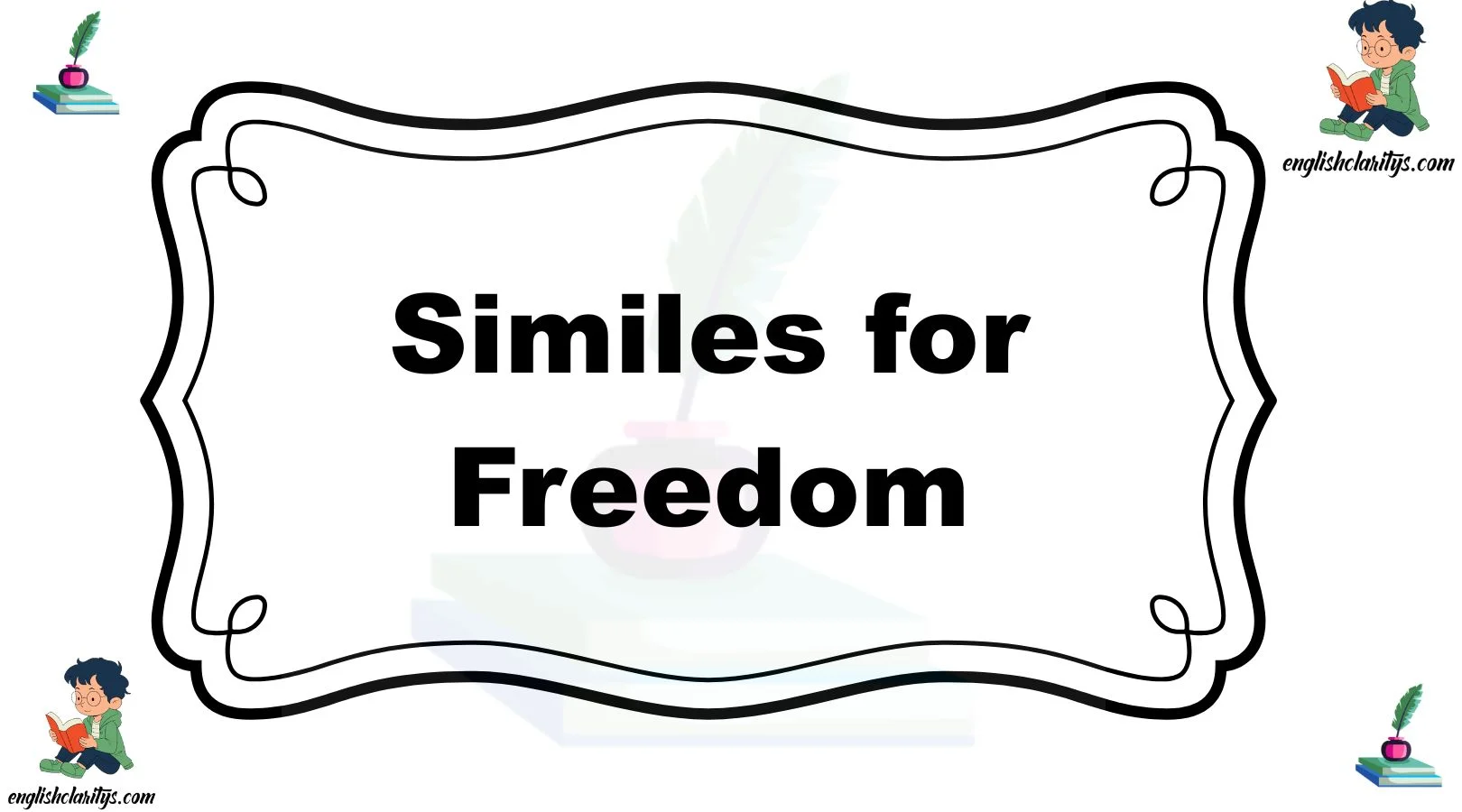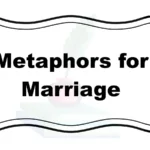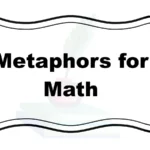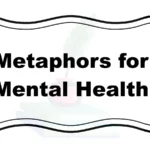Finding the right words to express emotions like freedom can truly make your message resonate on a deeper level. Using similes—those vivid comparisons that bring images and feelings to life—can add warmth, care, and personality to your communication.
Whether you’re writing a poem, giving a speech, or simply sharing your thoughts, having creative and thoughtful ways to describe freedom helps you connect meaningfully with your audience. This article will guide you through 25 similes for freedom, complete with explanations, examples, and tips on when and how to use them. Let’s dive into the beauty of expressing freedom in a way that feels genuine and heartfelt.
What Does “Freedom” Mean?
Freedom is the state of being free, where one is not confined by restrictions, oppression, or limitations. It represents the power or right to act, speak, or think without hindrance or restraint. Freedom can be physical, emotional, or mental — from the liberty to move freely to the inner peace of releasing worries. It’s a profound and valuable human experience that inspires hope, courage, and self-expression.
When to Use “Freedom”
You might want to use the concept of freedom when discussing topics like personal growth, rights, creativity, or breaking away from constraints. It’s powerful in motivational speeches, creative writing, or conversations about social justice. Using similes to describe freedom adds vivid imagery that helps your audience feel the emotion behind the word.
Pros and Cons of Using Similes for Freedom
Pros:
- Makes descriptions more vivid and memorable
- Evokes emotional responses from the audience
- Adds warmth and personal touch to communication
Cons:
- Overuse can make writing seem clichéd
- May confuse the audience if the comparison is unclear
- Needs to be chosen carefully to fit tone and context
1. Freedom is like a bird soaring in the sky
Definition: Freedom is compared to a bird flying freely through the open sky.
Explanation: Birds symbolize liberty as they move without boundaries, unrestricted by walls or fences.
Scenario Example: After quitting her stressful job, Sarah felt like a bird soaring in the sky, finally free to chase her dreams.
Best Use: Ideal for expressing relief, joy, and the exhilaration of release.
Tone: Uplifting, hopeful, and inspiring.
Other Ways to Say:
- Freedom is like a kite dancing in the wind
- Freedom is like a plane gliding through open clouds
- Freedom is like an eagle riding the wind currents
2. Freedom is like a river flowing endlessly
Definition: Freedom is compared to a river that moves continuously without obstruction.
Explanation: A river’s endless flow represents ongoing movement and the absence of barriers.
Scenario Example: When Mark moved to a new country, he felt his spirit flow like a river flowing endlessly, unrestricted and full of life.
Best Use: Great for describing continuous progress and natural ease.
Tone: Calm, steady, and fluid.
Other Ways to Say:
- Freedom is like the ocean waves breaking free
- Freedom is like a stream cutting through mountains
- Freedom is like a waterfall cascading without pause
3. Freedom is like the wind whispering through trees
Definition: Freedom is likened to the gentle, unseen wind moving through leaves.
Explanation: The wind’s invisible, yet powerful presence embodies freedom’s subtle but pervasive essence.
Scenario Example: After overcoming fear, Jenna felt freedom like the wind whispering through trees—soft yet undeniable.
Best Use: Perfect for expressing gentle, soothing freedom or quiet liberation.
Tone: Peaceful, subtle, and comforting.
Other Ways to Say:
- Freedom is like a breeze on a summer day
- Freedom is like a gentle gust shaking loose the past
- Freedom is like a soft sigh through the branches
4. Freedom is like a wild stallion running free
Definition: Freedom is compared to a strong horse running unbridled across open land.
Explanation: The wild stallion symbolizes strength, power, and unrestrained movement.
Scenario Example: He left the corporate world behind and felt like a wild stallion running free across endless plains.
Best Use: Ideal when describing passionate, energetic, and powerful freedom.
Tone: Bold, fierce, and empowering.
Other Ways to Say:
- Freedom is like a lion roaring in the jungle
- Freedom is like a cheetah sprinting on the savannah
- Freedom is like a wolf howling at the moon
5. Freedom is like the sunrise breaking through darkness
Definition: Freedom is likened to the first light of dawn piercing the night.
Explanation: The sunrise signifies hope, new beginnings, and the end of confinement.
Scenario Example: After years of struggle, her freedom was like the sunrise breaking through darkness—bright and promising.
Best Use: Best for hopeful, transformative moments of liberation.
Tone: Warm, optimistic, and renewing.
Other Ways to Say:
- Freedom is like the first bloom of spring
- Freedom is like light breaking a stormy sky
- Freedom is like a candle flickering in the night
6. Freedom is like a sailboat catching the wind
Definition: Freedom is compared to a sailboat moving effortlessly with the breeze.
Explanation: The sailboat’s movement depends on the wind, symbolizing harmony with natural forces and freedom’s grace.
Scenario Example: As she started her own business, freedom felt like a sailboat catching the wind, moving forward with ease.
Best Use: Useful for describing smooth progress and synergy with circumstances.
Tone: Calm, balanced, and adventurous.
Other Ways to Say:
- Freedom is like a balloon floating into the sky
- Freedom is like a paper plane soaring on air currents
- Freedom is like a leaf drifting on a river
7. Freedom is like a flame dancing in the dark
Definition: Freedom is likened to a small, lively flame that illuminates darkness.
Explanation: The flame represents resilience and hope even in the toughest situations.
Scenario Example: No matter what challenges came, his spirit’s freedom was like a flame dancing in the dark.
Best Use: Great for resilience and inner strength themes.
Tone: Hopeful, warm, and spirited.
Other Ways to Say:
- Freedom is like a candle burning bright
- Freedom is like a spark igniting a forest fire
- Freedom is like a lighthouse beacon in the storm
8. Freedom is like a child running through a field
Definition: Freedom is compared to a child’s uninhibited joy and energy in open space.
Explanation: Children symbolize innocence and spontaneous expression, free from adult constraints.
Scenario Example: After leaving her worries behind, she felt like a child running through a field, pure joy in every step.
Best Use: Expresses innocence, happiness, and carefree spirit.
Tone: Playful, joyful, and lighthearted.
Other Ways to Say:
- Freedom is like a puppy chasing butterflies
- Freedom is like laughter echoing in the wind
- Freedom is like a kite soaring on a windy day
9. Freedom is like the open road stretching ahead
Definition: Freedom is likened to a long, open path with endless possibilities.
Explanation: The open road suggests adventure, choice, and the absence of barriers.
Scenario Example: When he quit his job to travel, freedom felt like the open road stretching ahead—full of promise.
Best Use: Perfect for journeys, adventure, and new beginnings.
Tone: Adventurous, hopeful, and optimistic.
Other Ways to Say:
- Freedom is like a trail winding through the mountains
- Freedom is like a highway with no speed limits
- Freedom is like a pathway lit by stars
10. Freedom is like a song that can’t be silenced
Definition: Freedom is compared to music that expresses the soul freely and loudly.
Explanation: The unstoppable song symbolizes expression and the refusal to be muted.
Scenario Example: Her ideas flowed freely, like a song that couldn’t be silenced.
Best Use: Great for creative, expressive freedom.
Tone: Bold, passionate, and lively.
Other Ways to Say:
- Freedom is like a shout echoing across valleys
- Freedom is like a drum beating through the night
- Freedom is like a melody that fills the air
11. Freedom is like a kite soaring high in the sky
Definition: Freedom is compared to a kite flying freely, controlled yet unbound.
Explanation: The kite reflects both guidance and liberty, moving with the wind.
Scenario Example: She felt her creativity soar like a kite high in the sky after starting her art project.
Best Use: Describes balanced freedom, where there’s direction but no confinement.
Tone: Light, uplifting, and hopeful.
Other Ways to Say:
- Freedom is like a balloon rising without limits
- Freedom is like a butterfly fluttering through flowers
- Freedom is like a leaf riding the breeze
12. Freedom is like a flame that cannot be extinguished
Definition: Freedom is compared to a persistent flame that survives against odds.
Explanation: The flame is a symbol of undying hope and spirit.
Scenario Example: Despite setbacks, her will for freedom was like a flame that could not be extinguished.
Best Use: For unwavering determination and resilience.
Tone: Strong, hopeful, and passionate.
Other Ways to Say:
- Freedom is like a fire that burns through the night
- Freedom is like a star shining in darkness
- Freedom is like an ember glowing in ashes
13. Freedom is like an eagle’s flight at dawn
Definition: Freedom is compared to the majestic flight of an eagle in the early morning.
Explanation: The eagle’s flight is powerful and free, symbolizing vision and strength.
Scenario Example: He embraced his new life, feeling freedom like an eagle’s flight at dawn.
Best Use: Perfect for strength and fresh beginnings.
Tone: Majestic, powerful, and uplifting.
Other Ways to Say:
- Freedom is like a hawk soaring above cliffs
- Freedom is like a falcon diving through the sky
- Freedom is like a bird gliding over mountains
14. Freedom is like the first breath of spring
Definition: Freedom is likened to the fresh, renewing air that signals new life.
Explanation: It suggests renewal, hope, and fresh starts.
Scenario Example: Leaving the past behind felt like the first breath of spring—full of promise and freedom.
Best Use: Ideal for renewal and optimism themes.
Tone: Fresh, hopeful, and gentle.
Other Ways to Say:
- Freedom is like morning dew on new leaves
- Freedom is like blossoms opening in sunlight
- Freedom is like a gentle rain washing away dust
15. Freedom is like a wave crashing on the shore
Definition: Freedom is compared to a powerful wave breaking free from the ocean.
Explanation: The wave symbolizes energy, release, and unstoppable force.
Scenario Example: His anger turned to freedom, like a wave crashing on the shore.
Best Use: For passionate, energetic expressions.
Tone: Powerful, dynamic, and intense.
Other Ways to Say:
- Freedom is like a storm breaking over mountains
- Freedom is like lightning flashing through the sky
- Freedom is like thunder rolling across fields
16. Freedom is like a butterfly escaping the cocoon
Definition: Freedom is compared to a butterfly emerging from its restrictive cocoon.
Explanation: The transformation symbolizes growth and release.
Scenario Example: She felt reborn, like a butterfly escaping the cocoon into the open air.
Best Use: Ideal for transformation and personal growth themes.
Tone: Gentle, hopeful, and inspiring.
Other Ways to Say:
- Freedom is like a seed sprouting from the soil
- Freedom is like a flower blooming after winter
- Freedom is like dawn breaking after a long night
17. Freedom is like clouds drifting across the sky
Definition: Freedom is likened to clouds moving freely with the wind.
Explanation: Clouds symbolize lightness and lack of fixed boundaries.
Scenario Example: After the tough year, he felt freedom like clouds drifting peacefully across the sky.
Best Use: For peaceful, effortless freedom.
Tone: Calm, soothing, and light.
Other Ways to Say:
- Freedom is like a leaf floating on a breeze
- Freedom is like smoke rising into open air
- Freedom is like mist rolling over hills
18. Freedom is like a horse galloping across the plains
Definition: Freedom is compared to the fast, unrestricted running of a horse.
Explanation: The horse’s gallop symbolizes power, speed, and unbound movement.
Scenario Example: Starting his own company made him feel like a horse galloping freely across wide plains.
Best Use: For energy and boldness in freedom.
Tone: Strong, lively, and adventurous.
Other Ways to Say:
- Freedom is like a deer leaping through forests
- Freedom is like a cheetah chasing the wind
- Freedom is like a stallion racing the horizon
19. Freedom is like the clear blue sky
Definition: Freedom is likened to the endless expanse of a bright, cloudless sky.
Explanation: It symbolizes openness, clarity, and limitless potential.
Scenario Example: After moving abroad, she felt her future open like the clear blue sky.
Best Use: To express optimism and endless possibility.
Tone: Bright, hopeful, and expansive.
Other Ways to Say:
- Freedom is like a vast desert under sunlight
- Freedom is like open fields stretching endlessly
- Freedom is like a shining star in the night
20. Freedom is like a melody soaring in the wind
Definition: Freedom is compared to music carried freely through the air.
Explanation: The melody represents expressive, joyful movement without restrictions.
Scenario Example: When dancing without care, he felt like a melody soaring in the wind.
Best Use: Expresses joyful, artistic freedom.
Tone: Light, joyful, and expressive.
Other Ways to Say:
- Freedom is like a song flowing through trees
- Freedom is like a harp string vibrating in the breeze
- Freedom is like laughter carried across valleys
21. Freedom is like a flame lighting up the night
Definition: Freedom is likened to a bright flame shining in darkness.
Explanation: The flame represents hope and guidance during difficult times.
Scenario Example: Her courage shone like a flame lighting up the night, a symbol of her freedom.
Best Use: For hope and resilience.
Tone: Warm, inspiring, and steady.
Other Ways to Say:
- Freedom is like a beacon on a stormy coast
- Freedom is like stars twinkling in black skies
- Freedom is like a torch carried through darkness
22. Freedom is like leaves dancing in the breeze
Definition: Freedom is compared to leaves moving freely with the wind.
Explanation: It symbolizes playful, spontaneous movement.
Scenario Example: In the park, she felt carefree, like leaves dancing in the breeze.
Best Use: For lighthearted, joyful freedom.
Tone: Playful, carefree, and gentle.
Other Ways to Say:
- Freedom is like petals floating on water
- Freedom is like feathers drifting through air
- Freedom is like bubbles rising in sunlight
23. Freedom is like a kite cut loose from its string
Definition: Freedom is likened to a kite suddenly released from control.
Explanation: It symbolizes sudden release and unrestrained flight.
Scenario Example: When he quit the toxic job, he felt like a kite cut loose from its string.
Best Use: For dramatic, liberating moments.
Tone: Dramatic, freeing, and exhilarating.
Other Ways to Say:
- Freedom is like a balloon slipping from a child’s grasp
- Freedom is like a bird breaking from its cage
- Freedom is like a leaf torn from the branch
24. Freedom is like a river breaking through a dam
Definition: Freedom is compared to water forcefully escaping a barrier.
Explanation: It symbolizes unstoppable release and power.
Scenario Example: Her voice rose, powerful and clear, like a river breaking through a dam.
Best Use: For intense, overwhelming freedom.
Tone: Forceful, intense, and triumphant.
Other Ways to Say:
- Freedom is like a flood overwhelming a valley
- Freedom is like lava bursting from a volcano
- Freedom is like thunder shattering silence
25. Freedom is like an open book waiting to be written
Definition: Freedom is likened to endless possibilities symbolized by a blank book.
Explanation: It represents choice, creativity, and the future yet to come.
Scenario Example: Starting fresh felt like an open book waiting to be written, full of freedom.
Best Use: For hopeful, creative, and future-focused freedom.
Tone: Optimistic, inspiring, and open.
Other Ways to Say:
- Freedom is like a blank canvas ready for paint
- Freedom is like a stage awaiting the performer
- Freedom is like a new day without limits
Conclusion:
Freedom is a deeply personal and powerful experience that can be described in countless beautiful ways. Using similes allows us to paint pictures with words that evoke emotion and connection. Whether you choose to describe freedom as a soaring bird, a flowing river, or a dancing flame, these comparisons help communicate the essence of liberty with warmth and meaning. Remember to match the tone and context when choosing your simile to ensure it feels authentic and heartfelt. Embracing creative expressions for freedom not only enriches your language but also invites others to feel the beauty and importance of living free.
MCQs:
1. Which simile best describes freedom as unstoppable and powerful?
a) Like a bird soaring in the sky
b) Like a river breaking through a dam
c) Like leaves dancing in the breeze
d) Like a flame flickering
2. Which simile evokes a gentle, soothing sense of freedom?
a) Like the wind whispering through trees
b) Like a wild stallion running free
c) Like a storm breaking over mountains
d) Like thunder rolling across fields
3. What simile would best express a fresh start or renewal?
a) Like the first breath of spring
b) Like a kite cut loose from its string
c) Like a wave crashing on the shore
d) Like a flame dancing in the dark
4. Which simile symbolizes freedom as joyful and carefree?
a) Like a child running through a field
b) Like a river flowing endlessly
c) Like a flame lighting up the night
d) Like an eagle’s flight at dawn
5. What simile shows freedom as creative and expressive?
a) Like a song that can’t be silenced
b) Like a horse galloping across the plains
c) Like clouds drifting across the sky
d) Like a river breaking through a dam
6. Which simile best fits the idea of resilience in freedom?
a) Like a flame that cannot be extinguished
b) Like a leaf drifting on a breeze
c) Like petals on water
d) Like clouds in the sky
7. Which simile shows an adventurous type of freedom?
a) Like the open road stretching ahead
b) Like a candle burning bright
c) Like a butterfly in sunlight
d) Like mist rolling in
8. Which simile reflects inner peace?
a) Like a river flowing endlessly
b) Like a child running through a field
c) Like a wild stallion running
d) Like thunder echoing
9. Which simile describes a sudden release from control?
a) Like a kite cut loose from its string
b) Like a flower blooming
c) Like a sailboat catching the wind
d) Like laughter in the air
10. Which simile expresses freedom as a quiet strength?
a) Like a flame lighting up the night
b) Like a wild stallion running free
c) Like thunder in the mountains
d) Like waves crashing
11. What simile best describes freedom as full of possibilities?
a) Like an open book waiting to be written
b) Like a balloon floating
c) Like laughter echoing
d) Like thunder rolling
12. Which simile suggests emotional transformation and growth?
a) Like a butterfly escaping the cocoon
b) Like a wave crashing
c) Like thunder in the sky
d) Like a kite soaring
13. Which simile shows a subtle yet impactful kind of freedom?
a) Like the wind whispering through trees
b) Like a cheetah sprinting
c) Like a stallion galloping
d) Like lava bursting
14. Which simile would work well in a romantic setting?
a) Like leaves dancing in the breeze
b) Like a river breaking through a dam
c) Like thunder echoing in the hills
d) Like lightning in the sky
15. Which simile feels best for describing freedom through music or art?
a) Like a melody soaring in the wind
b) Like a stallion racing
c) Like a kite cut loose
d) Like thunder rolling
Answers:
- b) Like a river breaking through a dam
- a) Like the wind whispering through trees
- a) Like the first breath of spring
- a) Like a child running through a field
- a) Like a song that can’t be silenced
- a) Like a flame that cannot be extinguished
- a) Like the open road stretching ahead
- a) Like a river flowing endlessly
- a) Like a kite cut loose from its string
- a) Like a flame lighting up the night
- a) Like an open book waiting to be written
- a) Like a butterfly escaping the cocoon
- a) Like the wind whispering through trees
- a) Like leaves dancing in the breeze
- a) Like a melody soaring in the wind
FAQs:
1. Why use similes to describe freedom?
Using similes helps paint a more vivid and emotional picture of what freedom feels like. Instead of stating it plainly, similes bring your words to life, making them more relatable, heartfelt, and memorable. Whether in writing or speech, these comparisons help others feel what you mean.
2. Are similes better than metaphors for expressing emotions like freedom?
Both similes and metaphors are powerful, but similes tend to be more accessible and gentle, especially in emotional contexts. By using “like” or “as,” similes allow space for interpretation and keep your tone warm and thoughtful, which can be perfect when expressing sensitive feelings like freedom.
3. Can I use these similes in professional writing or speeches?
Absolutely. Many of these similes work well in motivational speeches, essays, or creative writing, especially when your tone is inspirational, empowering, or poetic. Just make sure the simile fits the formality and message of your piece. For example, “Freedom is like the open road” works beautifully in a graduation speech or a personal essay.
4. How do I know which simile for freedom to choose?
Consider the emotion or mood you want to convey:
- For joy: “Freedom is like a child running through a field.”
- For power: “Freedom is like a wave crashing on the shore.”
- For peace: “Freedom is like clouds drifting across the sky.”
Choose the one that matches your tone, audience, and message.
5. Can I create my own similes for freedom?
Yes, and you should! Creating your own similes is a great way to personalise your message and connect authentically. Think about what freedom feels like to you—is it a sound, a place, or a sensation? Then compare it using “like” or “as” in a way that captures that feeling. Your unique voice adds even more power to the words.




